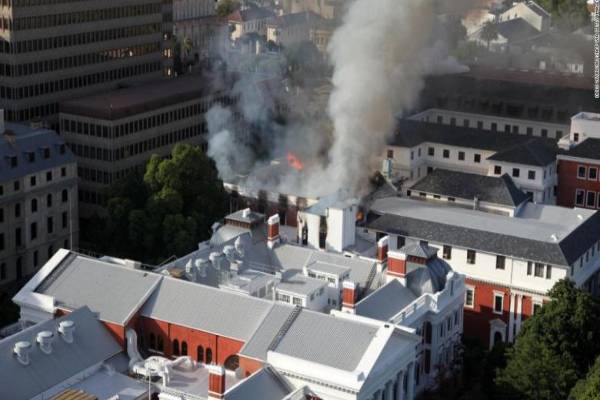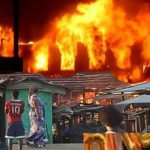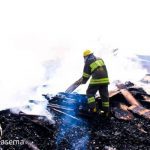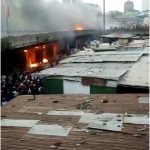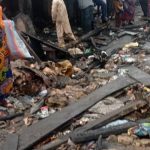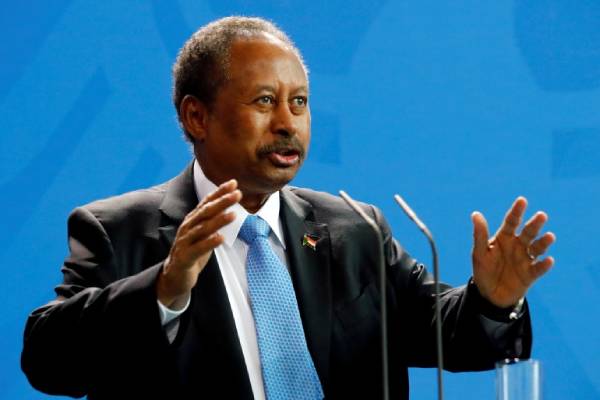A major fire at the South African parliament has caused extensive damage on Sunday, collapsing the roof and gutting an entire floor in one building, while a man in his 50s was arrested in connection with the blaze.
The fire broke out in the early morning and authorities said the sprinkler system appeared to have been tampered with and so did not work.
By afternoon, some 70 firefighters were still trying to contain the blaze in one of the several buildings that make up the parliament complex in the legislative capital, Cape Town.
A person was arrested inside parliament, Public Works and Infrastructure Minister Patricia De Lille told reporters, adding that the case had been handed over to an elite police unit called the Hawks.
“It’s the role of the Hawks to investigate any attack on political institutions,” De Lille said.
Parliament said in a statement the suspect was a man in his 50s.
There were no reports of any injuries.
The cause of the blaze was not yet known but De Lille said that according to a report that she received, a standard maintenance fire drill had been conducted just before parliament closed for the Christmas and New Year holidays and everything including the sprinklers was working.
“What was discovered this morning is that somebody has closed one of the valves and so then there was no water to trigger that automatic sprinkler system coming on,” De Lille said, adding that CCTV footage confirmed that somebody was in the building from the early hours of the morning.
The precinct has three main sections, the original Parliament building completed in the late 1800s and two newer parts built in the 20th century. Historical artefacts inside the premises are likely to have been damaged or destroyed.
The fire initially was concentrated at the old Parliament building, which is located behind the National Assembly, De Lille told reporters.
She had initially said firefighters had the situation under control, but the flames later spread to the current Parliament building.
President Cyril Ramaphosa arrived at parliament around 1:30 pm on Sunday accompanied by Premier Alan Winde and De Lille to view the damages.
Cape Town’s mayoral committee member for safety and security Jean-Pierre Smith said fire had also gutted the third floor of the Old Assembly building and that the roof had collapsed, including office space and the gymnasium.
Smith added that firefighters were still battling to bring the blaze under control and that two aircrafts had been deployed.
Ramaphosa and many of South Africa’s high-ranking politicians were in Cape Town for the funeral service of Archbishop Desmond Tutu, which took place on Saturday at the city’s St. George’s Cathedral, about a block away from the Parliament precinct.
A major fire at the South African parliament has caused extensive damage on Sunday, collapsing the roof and gutting an entire floor in one building, while a man in his 50s was arrested in connection with the blaze.
The fire broke out in the early morning and authorities said the sprinkler system appeared to have been tampered with and so did not work.
By afternoon, some 70 firefighters were still trying to contain the blaze in one of the several buildings that make up the parliament complex in the legislative capital, Cape Town.
A person was arrested inside parliament, Public Works and Infrastructure Minister Patricia De Lille told reporters, adding that the case had been handed over to an elite police unit called the Hawks.
“It’s the role of the Hawks to investigate any attack on political institutions,” De Lille said.
Parliament said in a statement the suspect was a man in his 50s.
There were no reports of any injuries.
The cause of the blaze was not yet known but De Lille said that according to a report that she received, a standard maintenance fire drill had been conducted just before parliament closed for the Christmas and New Year holidays and everything including the sprinklers was working.
“What was discovered this morning is that somebody has closed one of the valves and so then there was no water to trigger that automatic sprinkler system coming on,” De Lille said, adding that CCTV footage confirmed that somebody was in the building from the early hours of the morning.
The precinct has three main sections, the original Parliament building completed in the late 1800s and two newer parts built in the 20th century. Historical artefacts inside the premises are likely to have been damaged or destroyed.
The fire initially was concentrated at the old Parliament building, which is located behind the National Assembly, De Lille told reporters.
She had initially said firefighters had the situation under control, but the flames later spread to the current Parliament building.
President Cyril Ramaphosa arrived at parliament around 1:30 pm on Sunday accompanied by Premier Alan Winde and De Lille to view the damages.
Cape Town’s mayoral committee member for safety and security Jean-Pierre Smith said fire had also gutted the third floor of the Old Assembly building and that the roof had collapsed, including office space and the gymnasium.
Smith added that firefighters were still battling to bring the blaze under control and that two aircrafts had been deployed.
Ramaphosa and many of South Africa’s high-ranking politicians were in Cape Town for the funeral service of Archbishop Desmond Tutu, which took place on Saturday at the city’s St. George’s Cathedral, about a block away from the Parliament precinct.
A major fire at the South African parliament has caused extensive damage on Sunday, collapsing the roof and gutting an entire floor in one building, while a man in his 50s was arrested in connection with the blaze.
The fire broke out in the early morning and authorities said the sprinkler system appeared to have been tampered with and so did not work.
By afternoon, some 70 firefighters were still trying to contain the blaze in one of the several buildings that make up the parliament complex in the legislative capital, Cape Town.
A person was arrested inside parliament, Public Works and Infrastructure Minister Patricia De Lille told reporters, adding that the case had been handed over to an elite police unit called the Hawks.
“It’s the role of the Hawks to investigate any attack on political institutions,” De Lille said.
Parliament said in a statement the suspect was a man in his 50s.
There were no reports of any injuries.
The cause of the blaze was not yet known but De Lille said that according to a report that she received, a standard maintenance fire drill had been conducted just before parliament closed for the Christmas and New Year holidays and everything including the sprinklers was working.
“What was discovered this morning is that somebody has closed one of the valves and so then there was no water to trigger that automatic sprinkler system coming on,” De Lille said, adding that CCTV footage confirmed that somebody was in the building from the early hours of the morning.
The precinct has three main sections, the original Parliament building completed in the late 1800s and two newer parts built in the 20th century. Historical artefacts inside the premises are likely to have been damaged or destroyed.
The fire initially was concentrated at the old Parliament building, which is located behind the National Assembly, De Lille told reporters.
She had initially said firefighters had the situation under control, but the flames later spread to the current Parliament building.
President Cyril Ramaphosa arrived at parliament around 1:30 pm on Sunday accompanied by Premier Alan Winde and De Lille to view the damages.
Cape Town’s mayoral committee member for safety and security Jean-Pierre Smith said fire had also gutted the third floor of the Old Assembly building and that the roof had collapsed, including office space and the gymnasium.
Smith added that firefighters were still battling to bring the blaze under control and that two aircrafts had been deployed.
Ramaphosa and many of South Africa’s high-ranking politicians were in Cape Town for the funeral service of Archbishop Desmond Tutu, which took place on Saturday at the city’s St. George’s Cathedral, about a block away from the Parliament precinct.
A major fire at the South African parliament has caused extensive damage on Sunday, collapsing the roof and gutting an entire floor in one building, while a man in his 50s was arrested in connection with the blaze.
The fire broke out in the early morning and authorities said the sprinkler system appeared to have been tampered with and so did not work.
By afternoon, some 70 firefighters were still trying to contain the blaze in one of the several buildings that make up the parliament complex in the legislative capital, Cape Town.
A person was arrested inside parliament, Public Works and Infrastructure Minister Patricia De Lille told reporters, adding that the case had been handed over to an elite police unit called the Hawks.
“It’s the role of the Hawks to investigate any attack on political institutions,” De Lille said.
Parliament said in a statement the suspect was a man in his 50s.
There were no reports of any injuries.
The cause of the blaze was not yet known but De Lille said that according to a report that she received, a standard maintenance fire drill had been conducted just before parliament closed for the Christmas and New Year holidays and everything including the sprinklers was working.
“What was discovered this morning is that somebody has closed one of the valves and so then there was no water to trigger that automatic sprinkler system coming on,” De Lille said, adding that CCTV footage confirmed that somebody was in the building from the early hours of the morning.
The precinct has three main sections, the original Parliament building completed in the late 1800s and two newer parts built in the 20th century. Historical artefacts inside the premises are likely to have been damaged or destroyed.
The fire initially was concentrated at the old Parliament building, which is located behind the National Assembly, De Lille told reporters.
She had initially said firefighters had the situation under control, but the flames later spread to the current Parliament building.
President Cyril Ramaphosa arrived at parliament around 1:30 pm on Sunday accompanied by Premier Alan Winde and De Lille to view the damages.
Cape Town’s mayoral committee member for safety and security Jean-Pierre Smith said fire had also gutted the third floor of the Old Assembly building and that the roof had collapsed, including office space and the gymnasium.
Smith added that firefighters were still battling to bring the blaze under control and that two aircrafts had been deployed.
Ramaphosa and many of South Africa’s high-ranking politicians were in Cape Town for the funeral service of Archbishop Desmond Tutu, which took place on Saturday at the city’s St. George’s Cathedral, about a block away from the Parliament precinct.
A major fire at the South African parliament has caused extensive damage on Sunday, collapsing the roof and gutting an entire floor in one building, while a man in his 50s was arrested in connection with the blaze.
The fire broke out in the early morning and authorities said the sprinkler system appeared to have been tampered with and so did not work.
By afternoon, some 70 firefighters were still trying to contain the blaze in one of the several buildings that make up the parliament complex in the legislative capital, Cape Town.
A person was arrested inside parliament, Public Works and Infrastructure Minister Patricia De Lille told reporters, adding that the case had been handed over to an elite police unit called the Hawks.
“It’s the role of the Hawks to investigate any attack on political institutions,” De Lille said.
Parliament said in a statement the suspect was a man in his 50s.
There were no reports of any injuries.
The cause of the blaze was not yet known but De Lille said that according to a report that she received, a standard maintenance fire drill had been conducted just before parliament closed for the Christmas and New Year holidays and everything including the sprinklers was working.
“What was discovered this morning is that somebody has closed one of the valves and so then there was no water to trigger that automatic sprinkler system coming on,” De Lille said, adding that CCTV footage confirmed that somebody was in the building from the early hours of the morning.
The precinct has three main sections, the original Parliament building completed in the late 1800s and two newer parts built in the 20th century. Historical artefacts inside the premises are likely to have been damaged or destroyed.
The fire initially was concentrated at the old Parliament building, which is located behind the National Assembly, De Lille told reporters.
She had initially said firefighters had the situation under control, but the flames later spread to the current Parliament building.
President Cyril Ramaphosa arrived at parliament around 1:30 pm on Sunday accompanied by Premier Alan Winde and De Lille to view the damages.
Cape Town’s mayoral committee member for safety and security Jean-Pierre Smith said fire had also gutted the third floor of the Old Assembly building and that the roof had collapsed, including office space and the gymnasium.
Smith added that firefighters were still battling to bring the blaze under control and that two aircrafts had been deployed.
Ramaphosa and many of South Africa’s high-ranking politicians were in Cape Town for the funeral service of Archbishop Desmond Tutu, which took place on Saturday at the city’s St. George’s Cathedral, about a block away from the Parliament precinct.
A major fire at the South African parliament has caused extensive damage on Sunday, collapsing the roof and gutting an entire floor in one building, while a man in his 50s was arrested in connection with the blaze.
The fire broke out in the early morning and authorities said the sprinkler system appeared to have been tampered with and so did not work.
By afternoon, some 70 firefighters were still trying to contain the blaze in one of the several buildings that make up the parliament complex in the legislative capital, Cape Town.
A person was arrested inside parliament, Public Works and Infrastructure Minister Patricia De Lille told reporters, adding that the case had been handed over to an elite police unit called the Hawks.
“It’s the role of the Hawks to investigate any attack on political institutions,” De Lille said.
Parliament said in a statement the suspect was a man in his 50s.
There were no reports of any injuries.
The cause of the blaze was not yet known but De Lille said that according to a report that she received, a standard maintenance fire drill had been conducted just before parliament closed for the Christmas and New Year holidays and everything including the sprinklers was working.
“What was discovered this morning is that somebody has closed one of the valves and so then there was no water to trigger that automatic sprinkler system coming on,” De Lille said, adding that CCTV footage confirmed that somebody was in the building from the early hours of the morning.
The precinct has three main sections, the original Parliament building completed in the late 1800s and two newer parts built in the 20th century. Historical artefacts inside the premises are likely to have been damaged or destroyed.
The fire initially was concentrated at the old Parliament building, which is located behind the National Assembly, De Lille told reporters.
She had initially said firefighters had the situation under control, but the flames later spread to the current Parliament building.
President Cyril Ramaphosa arrived at parliament around 1:30 pm on Sunday accompanied by Premier Alan Winde and De Lille to view the damages.
Cape Town’s mayoral committee member for safety and security Jean-Pierre Smith said fire had also gutted the third floor of the Old Assembly building and that the roof had collapsed, including office space and the gymnasium.
Smith added that firefighters were still battling to bring the blaze under control and that two aircrafts had been deployed.
Ramaphosa and many of South Africa’s high-ranking politicians were in Cape Town for the funeral service of Archbishop Desmond Tutu, which took place on Saturday at the city’s St. George’s Cathedral, about a block away from the Parliament precinct.
A major fire at the South African parliament has caused extensive damage on Sunday, collapsing the roof and gutting an entire floor in one building, while a man in his 50s was arrested in connection with the blaze.
The fire broke out in the early morning and authorities said the sprinkler system appeared to have been tampered with and so did not work.
By afternoon, some 70 firefighters were still trying to contain the blaze in one of the several buildings that make up the parliament complex in the legislative capital, Cape Town.
A person was arrested inside parliament, Public Works and Infrastructure Minister Patricia De Lille told reporters, adding that the case had been handed over to an elite police unit called the Hawks.
“It’s the role of the Hawks to investigate any attack on political institutions,” De Lille said.
Parliament said in a statement the suspect was a man in his 50s.
There were no reports of any injuries.
The cause of the blaze was not yet known but De Lille said that according to a report that she received, a standard maintenance fire drill had been conducted just before parliament closed for the Christmas and New Year holidays and everything including the sprinklers was working.
“What was discovered this morning is that somebody has closed one of the valves and so then there was no water to trigger that automatic sprinkler system coming on,” De Lille said, adding that CCTV footage confirmed that somebody was in the building from the early hours of the morning.
The precinct has three main sections, the original Parliament building completed in the late 1800s and two newer parts built in the 20th century. Historical artefacts inside the premises are likely to have been damaged or destroyed.
The fire initially was concentrated at the old Parliament building, which is located behind the National Assembly, De Lille told reporters.
She had initially said firefighters had the situation under control, but the flames later spread to the current Parliament building.
President Cyril Ramaphosa arrived at parliament around 1:30 pm on Sunday accompanied by Premier Alan Winde and De Lille to view the damages.
Cape Town’s mayoral committee member for safety and security Jean-Pierre Smith said fire had also gutted the third floor of the Old Assembly building and that the roof had collapsed, including office space and the gymnasium.
Smith added that firefighters were still battling to bring the blaze under control and that two aircrafts had been deployed.
Ramaphosa and many of South Africa’s high-ranking politicians were in Cape Town for the funeral service of Archbishop Desmond Tutu, which took place on Saturday at the city’s St. George’s Cathedral, about a block away from the Parliament precinct.
A major fire at the South African parliament has caused extensive damage on Sunday, collapsing the roof and gutting an entire floor in one building, while a man in his 50s was arrested in connection with the blaze.
The fire broke out in the early morning and authorities said the sprinkler system appeared to have been tampered with and so did not work.
By afternoon, some 70 firefighters were still trying to contain the blaze in one of the several buildings that make up the parliament complex in the legislative capital, Cape Town.
A person was arrested inside parliament, Public Works and Infrastructure Minister Patricia De Lille told reporters, adding that the case had been handed over to an elite police unit called the Hawks.
“It’s the role of the Hawks to investigate any attack on political institutions,” De Lille said.
Parliament said in a statement the suspect was a man in his 50s.
There were no reports of any injuries.
The cause of the blaze was not yet known but De Lille said that according to a report that she received, a standard maintenance fire drill had been conducted just before parliament closed for the Christmas and New Year holidays and everything including the sprinklers was working.
“What was discovered this morning is that somebody has closed one of the valves and so then there was no water to trigger that automatic sprinkler system coming on,” De Lille said, adding that CCTV footage confirmed that somebody was in the building from the early hours of the morning.
The precinct has three main sections, the original Parliament building completed in the late 1800s and two newer parts built in the 20th century. Historical artefacts inside the premises are likely to have been damaged or destroyed.
The fire initially was concentrated at the old Parliament building, which is located behind the National Assembly, De Lille told reporters.
She had initially said firefighters had the situation under control, but the flames later spread to the current Parliament building.
President Cyril Ramaphosa arrived at parliament around 1:30 pm on Sunday accompanied by Premier Alan Winde and De Lille to view the damages.
Cape Town’s mayoral committee member for safety and security Jean-Pierre Smith said fire had also gutted the third floor of the Old Assembly building and that the roof had collapsed, including office space and the gymnasium.
Smith added that firefighters were still battling to bring the blaze under control and that two aircrafts had been deployed.
Ramaphosa and many of South Africa’s high-ranking politicians were in Cape Town for the funeral service of Archbishop Desmond Tutu, which took place on Saturday at the city’s St. George’s Cathedral, about a block away from the Parliament precinct.

